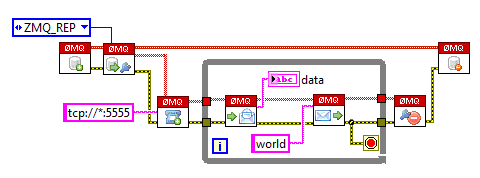ZeroMQ is sometimes called
"sockets on steroids" for greatly simplifying data transfer between computers. It is an open-source standard with many language bindings, eliminating the "black box" of LabVIEW's other solutions. Have a look at
The Guide for an introduction as to why ZMQ is revolutionary, the design patterns it provides, and why it's worth using in your applications.
News alert: LVZMQ now supports CURVE encryption

The LVZMQ project was an effort to create robust bindings to the ZeroMQ library in LabVIEW with a focus on being a stable maintainable package, true to the original implementation but friendly to the LabVIEW paradigm.
This project is stable on Windows platforms (both 32 and 64-bit), and can be compiled for other systems. Please check the FAQ for information. It can be installed easy using the VIPM package, or directly from the repository for the most up-to-date version.
This library simply wraps the C functions in ZeroMQ, so you can easily transform the many C examples available. Make sure to study
The Guide to understand the standard/recommended patterns. To demonstrate, some of the basic design patterns are showcased below.
Request/Reply
The "hello world" example below uses REQ/REP to demonstrate how to create a blocking server which waits for a connection and replies with a simple message

The client which connects to it is very simple, as demonstrated below:

Publish/Subscribe
Here's a simple PUB server which is transmitting to a python subscriber:

Note that in this example the PUB socket sends 5 messages but the SUB socket receives 4. This is called the "slow joiner" symptom and is underlying behaviour in ZeroMQ, to quote the guide "the subscriber will always miss the first messages that the publisher sends" (see the text in bold of the
relevant chapter).




